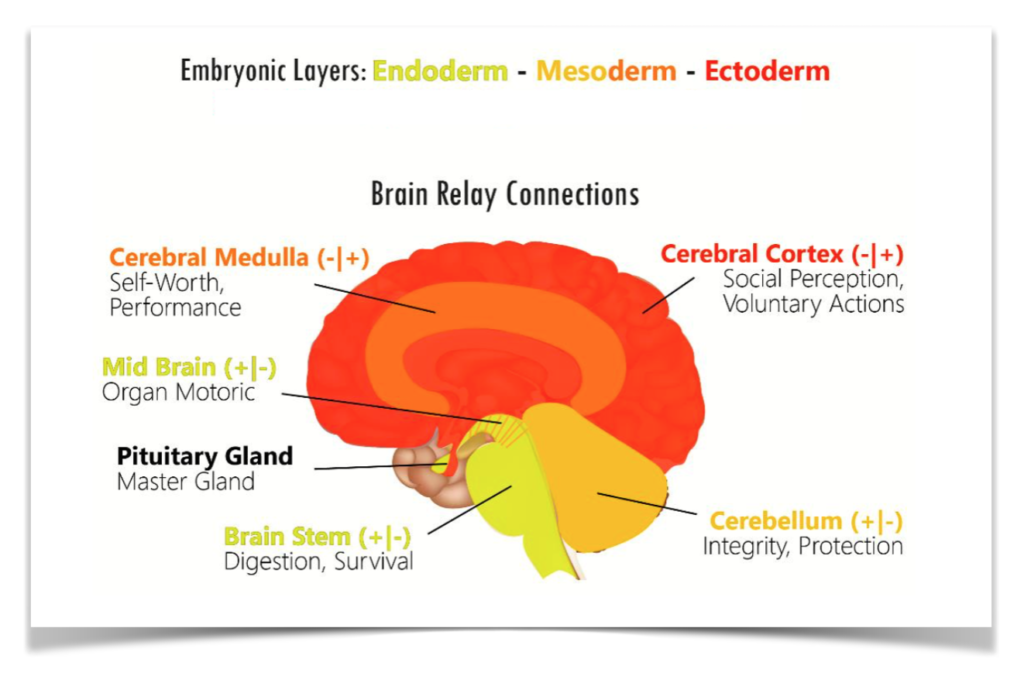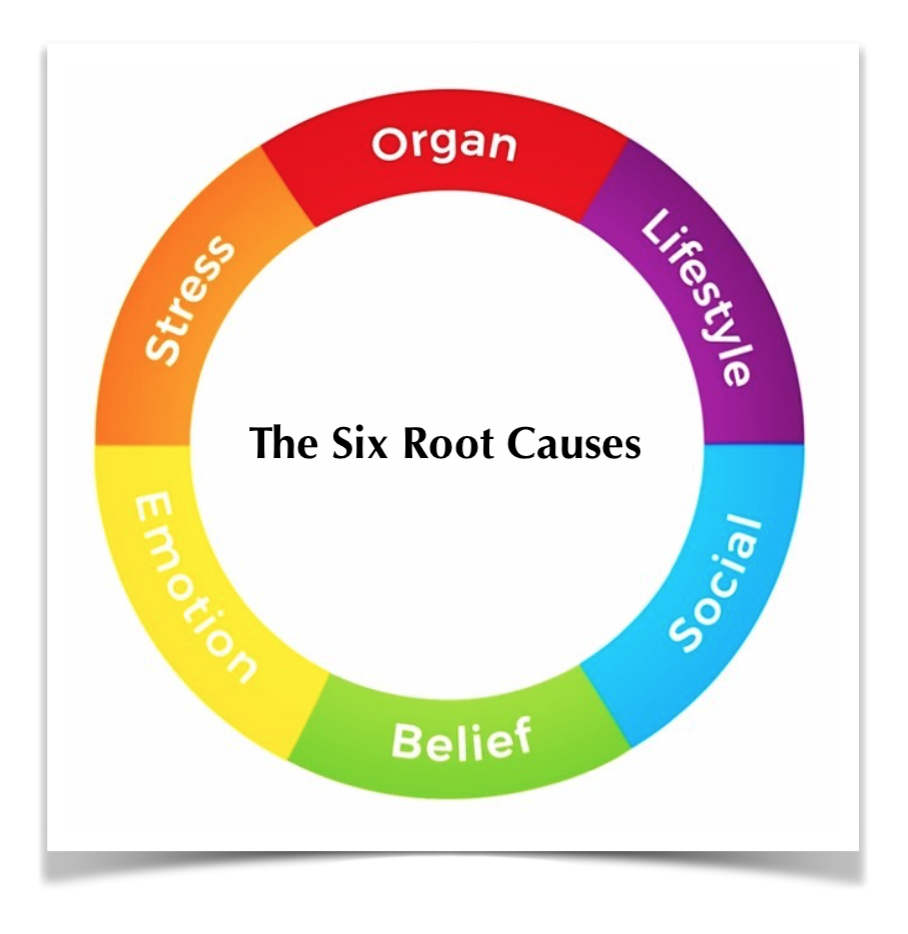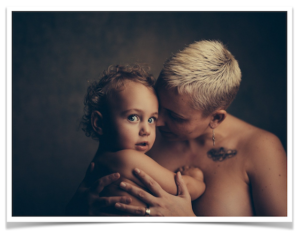Immune Support Tips & Ideas – Day 9
Immune Support Tips & Ideas – Day 8
Immune Support Tips & Ideas – Day 7
Tips: 19 – 21
Day 7 of this 10-day series of tips to support immune health, with kind permission from A. Vogel’s and their Healthy Way publication.
In today’s final tip, I make a mistake about who’s able to take a product I share. It’s for over 16s only. Not children under 16. I misread my notes in my haste. So my apologies for this.
I also talk about probiotic ideas to support gut health. And the best place I’ve found for all homemade fermented things is a blog called Nourished By Nature headed up by a wonderful Scottish lady called Janice.
This is my go-to for all fermented ideas and recipes. And the kimchi recipe is my absolute favourite daily dose of homemade probiotics. So check out her blog online.
As mentioned before, this mini-series was originally made for Instagram and so the first 3 videos I converted for here didn’t turn out well visually. So if you would prefer to view on Instagram, you can do so here.
If you have any questions about how to balance your own health and wellbeing, do get in touch and we can discuss how I can support you on your journey to reach your aspirations.
Where there is an imbalance of any form in our body, there is always an answer for how to rebalance it again, when we explore ourselves fully and look at the whole picture and broader perspective. To find out more about the six main root causes of illness and dis-ease, click here.
In the meantime, here is the video for Day 7 via YouTube…
Immune Support Tips & Ideas – Day 6
Tips 16 – 18
A few short simple tips for today, which I trust will help someone improve their immune health in some way.
Please share these videos if you like them. I’m making them in the spare time I have. I’m not being paid or sponsored.
The products I share are available for most budgets, rather than being more expensive and exclusive to those with higher incomes. That’s why I chose to approach A. Vogel’s and ask permission to share the tips from their Healthy Way publication.
There’s something simple which we can all do to help ourselves build a stronger immune system in this mini-series…so let me know how you get on. And if you would like personal guidance for your own health and wellbeing, then do get in touch, where I would be delighted to help and support you to find the root cause of your symptoms and diagnosis.
This entire mini-series is also available on Instagram if you would rather view them on that platform. You can find it all here.
Immune Support Tips & Ideas – Day 5
Immune Support Tips & Ideas – Day 4
Immune Support Tips & Ideas – Day 3
Our Sense of Touch & Contact – what our epidermis is really saying to us
I was six weeks old when my journey with skin symptoms began. It was eczema on my face…specifically around my mouth and on my cheeks. I was unexpectedly taken off my mother’s breast at six weeks, subsequently developing the characteristic redness of eczema on my face and also a very obvious intolerance to dairy formula milk. Coincidence? Read on…
The Sensory Skin System
The epidermis (the top layer of our skin) is predominantly responsible for sensory perception such as temperature, pressure, and touch. It covers the underlying dermis layer of skin (where acne develops from).
In terms of embryology, the epidermis originates from the ectoderm, which is part of the new brain and is therefore influenced and controlled from the cerebral cortex brain relay, or more specifically, the sensory cortex.
Why is this significant?
With the new scientific research which has been growing in the last few decades, and is now known as the new biology, we have come to realise and understand that there is a direct link between specific organ tissue, brain relay and embryology which indicates that our human needs are biological needs deeply rooted in our unconscious mind.
The symptoms which show up for us individuals are a result of a body-mind-social connection (see previous posts about this). Therefore, our symptoms are a direct reflection of our perception of unfulfilled biological needs e.g. emotions such as feeling safe, secure, accepted, confident etc – which in turn determine our values and beliefs and thus equate to why we experience, what to us as individuals, are perceived as conflict shocks and stress triggers at the moment they happen.
The Brain
The cerebral cortex part of the brain (the outer layer, which forms part of the new brain) is related to and concerned with the social part of our lives. It’s all about our relationships, both one-on-one relationships and in the greater family or tribe/community/society we’re part of; how we communicate in these relationships; how we fit into the hierarchy within this space and network; and having a sense of belonging in all of this.
When in balance, everything flows, The focus is for the greater good; it taps into our spiritual selves; we are present within and on the outside with others and we have a sense of being and meaning in all we’re doing, for the highest good of all.
Currently, our world is experiencing quite the imbalance in this area of life (and in all areas to be fair, with what’s going on globally). We’re seeing, feeling and hearing a lot which is creating a lot of stress within us, which is often being felt like a separation from the true sense of being and meaning in life; it feels like a loss of contact with the greater good of all.
Six Root Causes
As discussed in previous posts, there are six main root causes of symptoms which show up for us and usually it is a combination of two or more, which are out of balance within us, when we do present with symptoms, such as eczema, hives, measles, psoriasis, warts etc.
Briefly, these six root causes are the organ itself – how healthy is it?; stresses going on for us; emotions we’re feeling; beliefs we have about life and the world we live in; the social side of life (including work, home and outside social circles); and our lifestyle (which includes what we eat, what physical activity we do, our personal care products and rituals etc).
Stress trigger themes
From the mind-body-social functional medicine perspective which I work from, there is a biological stress trigger (conflict) theme linked to every organ and organ tissue in our body, which is connected to a specific brain relay, and this determines the level at which the conflict is being felt at.
With the epidermis layer of the skin, the theme is experienced as what is described as a separation conflict. This can be a loss of physical contact, from something or someone we want to be connected with and or to; or it can be a separation we would like to have or indeed need from someone or something which we do not want or like in some way shape or form.
So for example, like myself, at six weeks of age, I was suddenly separated from my mother’s breast and it was an unexpected, dramatic and isolating moment for me, where I didn’t have a strategy to fix or resolve it at that time. These four components are what constitute that stress trigger in our system – we call it a UDIN moment (Unexpected, Dramatic, Isolating, No Strategy).
Babies often experience this conflict when they’re separated from the mother at birth (e.g. being in ICU or given up for adoption). A separation conflict can occur in utero as well.
For an infant, the mother is the most important attachment presence in their young life, because of their connection during pregnancy and in the initial stages post-partum. Because of this connection and bond, it’s the mother who is perceived as the one to protect her child – she’s there on many levels to prevent stress and conflicts from happening. Therefore, it’s often the case, when a small child has a separation conflict, the mother was usually absent when the stress occurred.
Examples can be when a new sibling is born who appears to get more attention; when parents separate and children are split between homes; children not being able to see friends; separation from a toy or pet they like to snuggle. It’s also a pivotal time if the mother returns to work and the child is put into the care of others at nursery or a nanny or even another relative.
In parallel, elderly people may feel separated from their tribe/family if they move into a care home or following the death of a spouse or close companion.
Fears can also provoke the conflict e.g. fear of losing touch or contact with someone (maybe they’re moving away) or a feeling of rejection by a person because of an argument can trigger the conflict.
In a similar way, this theme also includes wanting to separate or cease contact from someone i.e. you really want to but for whatever reason, you’re unable to push or get away from that someone (literally or metaphorically). e.g. an abusive partner or parent or a bully at work or school.
Furthermore, it also refers to that desire/need/want to separate from something close to the skin e.g. glasses; a face mask; an item of clothing or a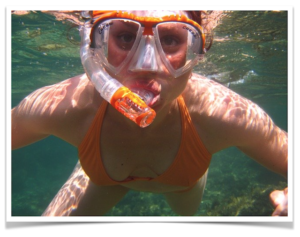 hat; shoes (such as bowling alley rental shoes); a soiled/wet baby’s nappy. By the same token, this theme also includes the feeling of being separated from something you’re unable to touch or feel close to any more e.g. a wedding ring, a musical instrument, a golf club (or similar sports item).
hat; shoes (such as bowling alley rental shoes); a soiled/wet baby’s nappy. By the same token, this theme also includes the feeling of being separated from something you’re unable to touch or feel close to any more e.g. a wedding ring, a musical instrument, a golf club (or similar sports item).
The Stress Phase
During this first phase, right after the trigger, the top layer of our skin, the epidermis, ulcerates where the separation/contact stress is felt. This is usually completely unnoticed because this is all happening in our subconscious and is a very sudden and automatic response to the emotive feeling.
However, when this stress phase is prolonged, signs of an imbalance will begin to surface, such as dry, rough, flaky, pale skin and coldness due to poor blood circulation.
If this stress phase becomes chronic, the skin starts to crack, which may include bleeding in more severe cases, leading to ulceration. Ichthyosis, which is identified by its fine scaling symptoms, indicates a chronic intense stress phase.
Another example of this prolonged stress phase is what is commonly known as dandruff on our scalp. When this is more intense and chronic, deep ulceration of the epidermal skin causes hair loss i.e. alopecia.
Other Stress Phase Aspects
Another common symptom which occurs in this stress phase, though not associated with epidermal skin issues in general medicine, is a short-term memory loss. The purpose of this is to temporarily forget the person we’ve been separated from by inhibiting the memory. In children, this shows up with challenges in learning and focusing…nowadays labelled as attention deficit disorder (ADD). In adults, chronic separation conflicts can lead to dementia.
Vitiligo is another symptom I’ve been managing since I was about 20. This happens because the ulceration (mentioned above), extends into the deepest 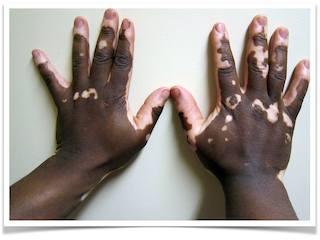 layer of the epidermal skin, where melanin is produced, or not as the case is with vitiligo. The stress of this type of separation is perceived by the individual as feeling especially intense or brutal, e.g. physical abuse or torn from a loved one. The symptoms show up where the separation is felt by that individual. Hair also turns white in these areas. For me, my armpits are almost totally white, along with some smaller patches on my arms, legs and shoulders. That said, because I’m working on the associated stress triggers for me, the pigmentation has begun to return.
layer of the epidermal skin, where melanin is produced, or not as the case is with vitiligo. The stress of this type of separation is perceived by the individual as feeling especially intense or brutal, e.g. physical abuse or torn from a loved one. The symptoms show up where the separation is felt by that individual. Hair also turns white in these areas. For me, my armpits are almost totally white, along with some smaller patches on my arms, legs and shoulders. That said, because I’m working on the associated stress triggers for me, the pigmentation has begun to return.
The Restorative Healing Phase
In the first part of the restorative healing phase, the affected skin location turns pinkish/red, before a slow repigmentation process begins in the second part of this phase. However, if you’re being retriggered by the original stress during this time, hyperpigmentation can occur – café-au-lait spots.
Another aspect of the first half of this healing phase is the skin swelling up, becoming red, inflamed, irritated, itchy, and sensitive to touch. This is because the ulceration from the stress phase is now being repaired through prolific cell growth. Unfortunately for those of us who know this only too well (me), this often includes small fluid-filled type blisters. Provided you don’t experience any retriggering stresses, the skin is able to further heal and repair in the second half of this phase. Those blisters will dry up and the skin returns to normal.
What is important to realise in this healing phase, however, is the skin does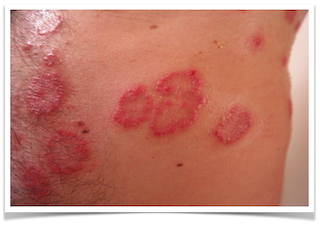 develop the characteristic rash we see in cases such as hives, eczema, lupus, measles, dermatitis, herpes, chickenpox, impetigo, rosacea, rubella and psoriasis. Though all slightly different, they all have the same separation/contact stress trigger theme in common.
develop the characteristic rash we see in cases such as hives, eczema, lupus, measles, dermatitis, herpes, chickenpox, impetigo, rosacea, rubella and psoriasis. Though all slightly different, they all have the same separation/contact stress trigger theme in common.
Location – the significance
When the separation is unwanted e.g. unable to cuddle a loved one, the symptoms most often appear on the inside of arms, hands, fingers, or legs. On the contrary, wanting to break contact/separate from someone, typically appears on the outside of arms, hands, elbows, legs, knees, shinbones, or ankles, to metaphorically push or kick the unwanted away.
Furthermore, depending on the detail of the stress and perception of the afflicted, skin rash symptoms can also be more pinpointed in where they appear e.g. the scalp, face or lips (i.e. cold sores); the chest, stomach, genitals (external); feet and toes; and the back.
When all over (which is what I experienced when the eczema was at its worst in my late 20s – head to toe, cracked and bleeding) a widespread skin rash indicates general stress being experienced as a whole. In this case, what is also important to know is this can also be caused by poisoning e.g. from medication i.e. the body as a whole wants to separate from this poison within.
When rash symptoms are chronic and recurring, it is due to the original stress being retriggered in some way. e.g. when I was suddenly taken off my mother’s breast at six weeks and given formula milk (derived from cow’s dairy) I not only developed eczema on my face, where I felt the separation from my mother’s breast, but I also developed a very obvious intolerance to cow’s dairy, which was subsequently removed from my diet. Therefore, what is important to realise is, foods or pets or plant pollen, for example, are often associated aspects of a separation conflict, because they were present at the time the stress was triggered and thus, an unconscious association is formed, as part of our fight or flight stress response, to help keep us safe.
Specifics
Rosacea and lupus, which generally appear on the nose, chin, and cheeks, are most often associated with a separation to do with the face e.g. loss of contact felt on the face or wanting someone to literally or metaphorically get out of your face. Nerve pain is also often experienced in the healing phase with facial skin rashes.
As we know with chickenpox (me again), measles and rubella, the rash covers most of the body. These general separation conflicts are more frequently encountered by young children because they tend to feel more vulnerable regarding separations from the tribe/family/unit (e.g. around home or at school).
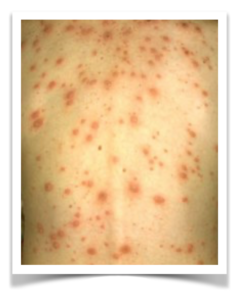 Chickenpox is felt much deeper than measles and rubella because it goes
Chickenpox is felt much deeper than measles and rubella because it goes
deeper into the epidermal skin layer. The length of the stress phase also impacts on the severity of symptoms too e.g. rubella is milder than measles. Other aspects also play a role with what symptoms occur as well e.g. if the child feels particularly isolated or abandoned, the blisters will appear worse or if the healing phase is intense, a high fever could also present.
Contrary to modern medical dogma, when we look at the science of human biology and embryology, coupled with the epigenetic science of the mind-body-social connection, these apparent contagious childhood viruses are actually the healing phase of separation conflicts being experienced by many children at the same time.
These communal separation conflicts can be and often are either school-related (e.g. a separation associated with a friend at school) or home-related impacting all children in a family.
For example, if you look at the statistics, measles typically appears after the settling in period of starting anew at nursery or infant school and the child has become familiar with their new teacher and made some friends. They’re also now comfortable with their new schedule of parents dropping and picking them up. The skin rash indicates that the stress of the separation has been resolved for the child. What spreads is the perceived notion/belief/emotion of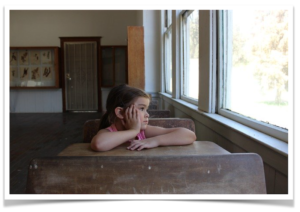 not being allowed or not wanting to have contact with someone who has the infection. Supposed outbreaks in schools, for example, are often associated with the fear of coming in contact with an infected child i.e. wanting to separate/not have contact. It can also be the loss of being connected with a new best friend.
not being allowed or not wanting to have contact with someone who has the infection. Supposed outbreaks in schools, for example, are often associated with the fear of coming in contact with an infected child i.e. wanting to separate/not have contact. It can also be the loss of being connected with a new best friend.
Psoriasis occurs because there are two conflicts involved. One is in the stress phase causing the flaky skin, while the second one is in the healing phase manifesting as the inflammation. Combined, it shows up as white/silvery patches on a thicker red skin surface.
Warts happen due to an on-going healing phase, because of being re-stressed. Skin tags are similar to warts. Genital warts suggest continuing separation conflicts of a sexual nature.
Remember: the healing phase is also interrupted when steroid-type creams are applied to the skin. This is why the inflamed rash appears again after the application is stopped.
My Own Journey
Having experienced eczema, chickenpox, impetigo, hives, cold sores, vitiligo and childhood warts, I’m very familiar with the themes of separation and unwanted contact, as well as how hard it is to live with these very visual symptoms on so many levels.
Looking over my own life, it’s clear and obvious where all these symptoms were activated and triggered. As such, coupled with the new biology knowledge and actually doing the deeper emotional work to heal those then unresolved emotional hurts, I’m happy to say I rarely if ever experience any symptoms nowadays. My vitiligo still has some work to complete. It’s in hand though and I’m well on my way to it also being a thing of the past.
As mentioned above, to ensure you’re getting to the root cause, all six key areas need to be explored and balanced for optimal results e.g. for a while, I thought consuming a healthy wholefood diet, being physically fit, doing work I love in a place I loved living in was enough. It soon became apparent the inner work needed to be done as well though. So my suggestion is to explore and cover all bases from the beginning, to avoid the setbacks I experienced.
To find out how I can help and support you, get in touch now.
Our Sense of Touch & Contact – what our epidermis is really saying to us
I was six weeks old when my journey with skin symptoms began. It was eczema on my face…specifically around my mouth and on my cheeks. I was unexpectedly taken off my mother’s breast at six weeks, subsequently developing the characteristic redness of eczema on my face and also a very obvious intolerance to dairy formula milk. Coincidence? Read on…
The Sensory Skin System
The epidermis (the top layer of our skin) is predominantly responsible for sensory perception such as temperature, pressure, and touch. It covers the underlying dermis layer of skin (where acne develops from).
In terms of embryology, the epidermis originates from the ectoderm, which is part of the new brain and is therefore influenced and controlled from the cerebral cortex brain relay, or more specifically, the sensory cortex.
Why is this significant?
With the new scientific research which has been growing in the last few decades, and is now known as the new biology, we have come to realise and understand that there is a direct link between specific organ tissue, brain relay and embryology which indicates that our human needs are biological needs deeply rooted in our unconscious mind.
The symptoms which show up for us individuals are a result of a body-mind-social connection (see previous posts about this). Therefore, our symptoms are a direct reflection of our perception of unfulfilled biological needs e.g. emotions such as feeling safe, secure, accepted, confident etc – which in turn determine our values and beliefs and thus equate to why we experience, what to us as individuals, are perceived as conflict shocks and stress triggers at the moment they happen.
The Brain
The cerebral cortex part of the brain (the outer layer, which forms part of the new brain) is related to and concerned with the social part of our lives. It’s all about our relationships, both one-on-one relationships and in the greater family or tribe/community/society we’re part of; how we communicate in these relationships; how we fit into the hierarchy within this space and network; and having a sense of belonging in all of this.
When in balance, everything flows, The focus is for the greater good; it taps into our spiritual selves; we are present within and on the outside with others and we have a sense of being and meaning in all we’re doing, for the highest good of all.
Currently, our world is experiencing quite the imbalance in this area of life (and in all areas to be fair, with what’s going on globally). We’re seeing, feeling and hearing a lot which is creating a lot of stress within us, which is often being felt like a separation from the true sense of being and meaning in life; it feels like a loss of contact with the greater good of all.
Six Root Causes
As discussed in previous posts, there are six main root causes of symptoms which show up for us and usually it is a combination of two or more, which are out of balance within us, when we do present with symptoms, such as eczema, hives, measles, psoriasis, warts etc.
Briefly, these six root causes are the organ itself – how healthy is it?; stresses going on for us; emotions we’re feeling; beliefs we have about life and the world we live in; the social side of life (including work, home and outside social circles); and our lifestyle (which includes what we eat, what physical activity we do, our personal care products and rituals etc).
Stress trigger themes
From the mind-body-social functional medicine perspective which I work from, there is a biological stress trigger (conflict) theme linked to every organ and organ tissue in our body, which is connected to a specific brain relay, and this determines the level at which the conflict is being felt at.
With the epidermis layer of the skin, the theme is experienced as what is described as a separation conflict. This can be a loss of physical contact, from something or someone we want to be connected with and or to; or it can be a separation we would like to have or indeed need from someone or something which we do not want or like in some way shape or form.
So for example, like myself, at six weeks of age, I was suddenly separated from my mother’s breast and it was an unexpected, dramatic and isolating moment for me, where I didn’t have a strategy to fix or resolve it at that time. These four components are what constitute that stress trigger in our system – we call it a UDIN moment (Unexpected, Dramatic, Isolating, No Strategy).
Babies often experience this conflict when they’re separated from the mother at birth (e.g. being in ICU or given up for adoption). A separation conflict can occur in utero as well.
For an infant, the mother is the most important attachment presence in their young life, because of their connection during pregnancy and in the initial stages post-partum. Because of this connection and bond, it’s the mother who is perceived as the one to protect her child – she’s there on many levels to prevent stress and conflicts from happening. Therefore, it’s often the case, when a small child has a separation conflict, the mother was usually absent when the stress occurred.
Examples can be when a new sibling is born who appears to get more attention; when parents separate and children are split between homes; children not being able to see friends; separation from a toy or pet they like to snuggle. It’s also a pivotal time if the mother returns to work and the child is put into the care of others at nursery or a nanny or even another relative.
In parallel, elderly people may feel separated from their tribe/family if they move into a care home or following the death of a spouse or close companion.
Fears can also provoke the conflict e.g. fear of losing touch or contact with someone (maybe they’re moving away) or a feeling of rejection by a person because of an argument can trigger the conflict.
In a similar way, this theme also includes wanting to separate or cease contact from someone i.e. you really want to but for whatever reason, you’re unable to push or get away from that someone (literally or metaphorically). e.g. an abusive partner or parent or a bully at work or school.
Furthermore, it also refers to that desire/need/want to separate from something close to the skin e.g. glasses; a face mask; an item of clothing or a hat; shoes (such as bowling alley rental shoes); a soiled/wet baby’s nappy. By the same token, this theme also includes the feeling of being separated from something you’re unable to touch or feel close to any more e.g. a wedding ring, a musical instrument, a golf club (or similar sports item).
hat; shoes (such as bowling alley rental shoes); a soiled/wet baby’s nappy. By the same token, this theme also includes the feeling of being separated from something you’re unable to touch or feel close to any more e.g. a wedding ring, a musical instrument, a golf club (or similar sports item).
The Stress Phase
During this first phase, right after the trigger, the top layer of our skin, the epidermis, ulcerates where the separation/contact stress is felt. This is usually completely unnoticed because this is all happening in our subconscious and is a very sudden and automatic response to the emotive feeling.
However, when this stress phase is prolonged, signs of an imbalance will begin to surface, such as dry, rough, flaky, pale skin and coldness due to poor blood circulation.
If this stress phase becomes chronic, the skin starts to crack, which may include bleeding in more severe cases, leading to ulceration. Ichthyosis, which is identified by its fine scaling symptoms, indicates a chronic intense stress phase.
Another example of this prolonged stress phase is what is commonly known as dandruff on our scalp. When this is more intense and chronic, deep ulceration of the epidermal skin causes hair loss i.e. alopecia.
Other Stress Phase Aspects
Another common symptom which occurs in this stress phase, though not associated with epidermal skin issues in general medicine, is a short-term memory loss. The purpose of this is to temporarily forget the person we’ve been separated from by inhibiting the memory. In children, this shows up with challenges in learning and focusing…nowadays labelled as attention deficit disorder (ADD). In adults, chronic separation conflicts can lead to dementia.
Vitiligo is another symptom I’ve been managing since I was about 20. This happens because the ulceration (mentioned above), extends into the deepest  layer of the epidermal skin, where melanin is produced, or not as the case is with vitiligo. The stress of this type of separation is perceived by the individual as feeling especially intense or brutal, e.g. physical abuse or torn from a loved one. The symptoms show up where the separation is felt by that individual. Hair also turns white in these areas. For me, my armpits are almost totally white, along with some smaller patches on my arms, legs and shoulders. That said, because I’m working on the associated stress triggers for me, the pigmentation has begun to return.
layer of the epidermal skin, where melanin is produced, or not as the case is with vitiligo. The stress of this type of separation is perceived by the individual as feeling especially intense or brutal, e.g. physical abuse or torn from a loved one. The symptoms show up where the separation is felt by that individual. Hair also turns white in these areas. For me, my armpits are almost totally white, along with some smaller patches on my arms, legs and shoulders. That said, because I’m working on the associated stress triggers for me, the pigmentation has begun to return.
The Restorative Healing Phase
In the first part of the restorative healing phase, the affected skin location turns pinkish/red, before a slow repigmentation process begins in the second part of this phase. However, if you’re being retriggered by the original stress during this time, hyperpigmentation can occur – café-au-lait spots.
Another aspect of the first half of this healing phase is the skin swelling up, becoming red, inflamed, irritated, itchy, and sensitive to touch. This is because the ulceration from the stress phase is now being repaired through prolific cell growth. Unfortunately for those of us who know this only too well (me), this often includes small fluid-filled type blisters. Provided you don’t experience any retriggering stresses, the skin is able to further heal and repair in the second half of this phase. Those blisters will dry up and the skin returns to normal.
What is important to realise in this healing phase, however, is the skin does develop the characteristic rash we see in cases such as hives, eczema, lupus, measles, dermatitis, herpes, chickenpox, impetigo, rosacea, rubella and psoriasis. Though all slightly different, they all have the same separation/contact stress trigger theme in common.
develop the characteristic rash we see in cases such as hives, eczema, lupus, measles, dermatitis, herpes, chickenpox, impetigo, rosacea, rubella and psoriasis. Though all slightly different, they all have the same separation/contact stress trigger theme in common.
Location – the significance
When the separation is unwanted e.g. unable to cuddle a loved one, the symptoms most often appear on the inside of arms, hands, fingers, or legs. On the contrary, wanting to break contact/separate from someone, typically appears on the outside of arms, hands, elbows, legs, knees, shinbones, or ankles, to metaphorically push or kick the unwanted away.
Furthermore, depending on the detail of the stress and perception of the afflicted, skin rash symptoms can also be more pinpointed in where they appear e.g. the scalp, face or lips (i.e. cold sores); the chest, stomach, genitals (external); feet and toes; and the back.
When all over (which is what I experienced when the eczema was at its worst in my late 20s – head to toe, cracked and bleeding) a widespread skin rash indicates general stress being experienced as a whole. In this case, what is also important to know is this can also be caused by poisoning e.g. from medication i.e. the body as a whole wants to separate from this poison within.
When rash symptoms are chronic and recurring, it is due to the original stress being retriggered in some way. e.g. when I was suddenly taken off my mother’s breast at six weeks and given formula milk (derived from cow’s dairy) I not only developed eczema on my face, where I felt the separation from my mother’s breast, but I also developed a very obvious intolerance to cow’s dairy, which was subsequently removed from my diet. Therefore, what is important to realise is, foods or pets or plant pollen, for example, are often associated aspects of a separation conflict, because they were present at the time the stress was triggered and thus, an unconscious association is formed, as part of our fight or flight stress response, to help keep us safe.
Specifics
Rosacea and lupus, which generally appear on the nose, chin, and cheeks, are most often associated with a separation to do with the face e.g. loss of contact felt on the face or wanting someone to literally or metaphorically get out of your face. Nerve pain is also often experienced in the healing phase with facial skin rashes.
As we know with chickenpox (me again), measles and rubella, the rash covers most of the body. These general separation conflicts are more frequently encountered by young children because they tend to feel more vulnerable regarding separations from the tribe/family/unit (e.g. around home or at school).
 Chickenpox is felt much deeper than measles and rubella because it goes
Chickenpox is felt much deeper than measles and rubella because it goes
deeper into the epidermal skin layer. The length of the stress phase also impacts on the severity of symptoms too e.g. rubella is milder than measles. Other aspects also play a role with what symptoms occur as well e.g. if the child feels particularly isolated or abandoned, the blisters will appear worse or if the healing phase is intense, a high fever could also present.
Contrary to modern medical dogma, when we look at the science of human biology and embryology, coupled with the epigenetic science of the mind-body-social connection, these apparent contagious childhood viruses are actually the healing phase of separation conflicts being experienced by many children at the same time.
These communal separation conflicts can be and often are either school-related (e.g. a separation associated with a friend at school) or home-related impacting all children in a family.
For example, if you look at the statistics, measles typically appears after the settling in period of starting anew at nursery or infant school and the child has become familiar with their new teacher and made some friends. They’re also now comfortable with their new schedule of parents dropping and picking them up. The skin rash indicates that the stress of the separation has been resolved for the child. What spreads is the perceived notion/belief/emotion of not being allowed or not wanting to have contact with someone who has the infection. Supposed outbreaks in schools, for example, are often associated with the fear of coming in contact with an infected child i.e. wanting to separate/not have contact. It can also be the loss of being connected with a new best friend.
not being allowed or not wanting to have contact with someone who has the infection. Supposed outbreaks in schools, for example, are often associated with the fear of coming in contact with an infected child i.e. wanting to separate/not have contact. It can also be the loss of being connected with a new best friend.
Psoriasis occurs because there are two conflicts involved. One is in the stress phase causing the flaky skin, while the second one is in the healing phase manifesting as the inflammation. Combined, it shows up as white/silvery patches on a thicker red skin surface.
Warts happen due to an on-going healing phase, because of being re-stressed. Skin tags are similar to warts. Genital warts suggest continuing separation conflicts of a sexual nature.
Remember: the healing phase is also interrupted when steroid-type creams are applied to the skin. This is why the inflamed rash appears again after the application is stopped.
My Own Journey
Having experienced eczema, chickenpox, impetigo, hives, cold sores, vitiligo and childhood warts, I’m very familiar with the themes of separation and unwanted contact, as well as how hard it is to live with these very visual symptoms on so many levels.
Looking over my own life, it’s clear and obvious where all these symptoms were activated and triggered. As such, coupled with the new biology knowledge and actually doing the deeper emotional work to heal those then unresolved emotional hurts, I’m happy to say I rarely if ever experience any symptoms nowadays. My vitiligo still has some work to complete. It’s in hand though and I’m well on my way to it also being a thing of the past.
As mentioned above, to ensure you’re getting to the root cause, all six key areas need to be explored and balanced for optimal results e.g. for a while, I thought consuming a healthy wholefood diet, being physically fit, doing work I love in a place I loved living in was enough. It soon became apparent the inner work needed to be done as well though. So my suggestion is to explore and cover all bases from the beginning, to avoid the setbacks I experienced.
To find out how I can help and support you, get in touch now.


